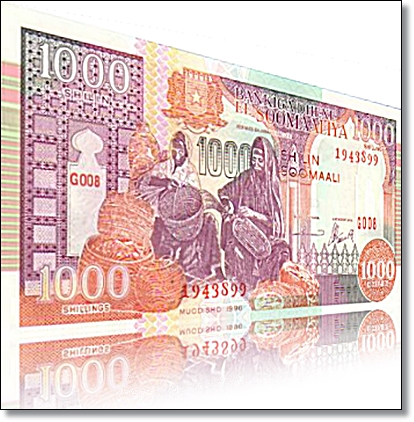Somalia: The Search for a Strong Shilling

 |
Historically, after attaining independence, northern Somalia colonized by Britain and southern regions under Italian rule united to form the Republic of Somalia. The Somali National Bank was established on the same day and the currency was named as the Somali Shilling (So.Sh). The currency had multiple denominations of: 5, 10, 20, 50, 100, 500 and 1000 shillings banknote, and 100, 50, 10, 5, and 1 cent coins.
After the collapse of the Siyad Barre regime, Somali shillings died gradually. I remember being able to use the 500 Somali Shilling (Shan Boqol Shilin Somali) but it become obsolete after 2001.
In 1991, Siad Barre was ousted from the office and forced to flee from the capital. Since then, Somalia had no strong central government and no monetary authority. Public institutions including the central bank were destroyed, or were used as private properties or as camps for Internally Displaced Peoples. After the collapse of the Central Bank and with the absence of the authority that used to manage the national currency, the control function of the Somali currency is left to no one.
One of the prerequisite of a currency is to be divisible. Divisible means dividing the currency into small parts that citizens can use. The Somali shilling lacks this important feature. 1000 Sh So (One thousand Shillings) is the only undividable currency we use today. The other important feature of every currency is portability. Is our currency portable today? I think our currency lacks this feature. For example, you cannot take $50 equivalent Somali shilling cash into your pocket. The $50 dollar Somali shilling is equivalent to 1,000, 000 (one million Somali shillings). Everybody is able to take in his/her pocket to$50 USD, but not 1, 000, 000 Somali shillings. This shows how the Somali shilling lacks important characteristics of currencies.
After the break of the civil war, the country has fragmented. Some regions issued their own separate banknotes. Somaliland which claims to have seceded from Somalia issued its own currency called the “Somaliland shilling.” It is reported that Puntland also has its own printing press. In 2001, the weak transition government sought help internationally to print the new Somali Shilling. Sudan paid the cost and printed for Somalia billions of new Somali banknotes, but because of opposition from national stakeholders and international financial institutions such as IMF and the World Bank, that money has not been delivered to Somalia.
The use of the U.S. dollar instead of our Somali shilling has become prevalent. More than ninety percent of salaries of employees are paid in dollars. Government workers are also paid in dollars. Transactions and purchases of major items, such as properties and remittances are also done with dollars. This shows how valueless our currency is today.
Advanced technology in the form of mobile phone payment or using mobile phone to send, receive or make a payment has become a handy solution to the shilling problem. This form of electronic payment became one of the most revolutionary technological developments in Somalia and it affected all segments of society. Majority of the Somalis use the mobile payment systems in their daily transactions instead of using the Somali Shilling. The school tuition fees are paid mostly in dollars or via the mobile payment. Both the local buses and beggars accept mobile payment and this shows how the Somali currency is dysfunctional as find other solutions.
Somalia's central bank has yet to find solutions to the nation's chronic currency problems. It failed to take the proper decision to revive the Somali currency by developing a new monetary policy and employing the right people, legal framework, and processes. It is encouraging that the government acknowledges the existence of this problem and is promising it will address the currency challenge. I am happy to hear that the president knows and is trying to finalize the prerequisite things of printing money.
Whether the government reintroduces the old Somali banknotes or issues a new currency, a new monetary policy is inevitable. We can no longer use indivisible one thousand Somali shilling as a national currency that cannot function beyond central regions. The relevant institutions need to set a new monetary policy.
The following steps can help add value to our valueless currency and solve the current problems:-
* First, the central bank, which is the institution responsible for the currency and monetary, should be empowered with competent human, legal and material resources.
* Second, the central bank should come up with a new monitory policy to solve the currency problems in the country.
* Third, there should be a system that ensures the mobile payment system and the currency work together. For example, specifying areas that people can use the mobile payment can minimize its effect.
* Finally, issuing a new currency should become a priority for the government. The establishing of a functioning central bank is also needed to discharge the bank's other duty to supervise commercial banks. The fact that such banks are being created across the country makes this even more urgently.
By Mahad Wasuge
The author mahad.wasuge@gmail.com is a researcher, lecturer and writer based in Mogadishu.
Courtesy: Hiiraan.
